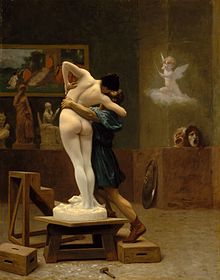Pügmalión


Pügmalión (görögül Πυγμαλίων, latinosan Pygmalion) az Ovidius Átváltozások című művében mint szobrász híressé vált legendás ciprusi személy neve. A név feltehetően a föníciai Pumayyaton király nevének görög változatán alapszik. Ovidius költeményében Pygmalion beleszeret saját szobrába melyet elefántcsontból faragott. Így Aphrodité ünnepén azt kérte az istennőtől ,hogy keltse életere szerelmét, Aphrodité ezt a kérést meg is valósította a fülig szerelmes Pügmaliónnak.
Párhuzamok a görög mitológiában
- A történetre számos művészeti alkotás utal, az egyik legismertebb George Bernard Shaw: Pygmalion című drámája.
- My Fair Lady (1964), George Cukor filmje.
- Pygmalion (1938), Anthony Asquith és Leslie Howard filmje.
További irodalom
- Essaka Joshua. (2001). Pygmalion and Galatea: The History of a Narrative in English Literature. Ashgate. (angolul)
- Kenneth Gross. (1992). The Dream of the Moving Statue. Cornell University Press. (A wide-ranging survey of 'living statues' in literature and the arts). (angolul)
- Jack Burnham. Beyond Modern Sculpture (1982). Allan Lane. (A history of 'living statues' and the fascination with automata - see the introductory chapter: "Sculpture and Automata"). (angolul)
- Ernst Buschor. Vom Sinn der griechischen Standbilder (1942). (Clear discussion of attitudes to sculptural images in classical times). (angolul)
- John J. Ciofalo. "The Art of Sex and Violence - The Sex and Violence of Art." The Self-Portraits of Francisco Goya. Cambridge University Press, 2001. (angolul)
- John J. Ciofalo. "Unveiling Goya's Rape of Galatea." Art History (December 1995), pp. 477–98. (angolul)
- Gail Marshall. (1998). Actresses on the Victorian Stage: Feminine Performance and the Galatea Myth. Cambridge University Press. (angolul)
- Alexandra K. Wettlaufer. (2001). Pen Vs. Paintbrush: Girodet, Balzac, and the Myth of Pygmalion in Post-Revolutionary France. Palgrave Macmillan. (angolul)
- Danahay, Martin A. (1994) "Mirrors of Masculine Desire: Narcissus and Pygmalion in Victorian Representation". Victorian Poetry, No. 32, 1994: pages 35–53. (angolul)
- Edward A. Shanken. (2005) “Hot 2 Bot: Pygmalion’s Lust, the Maharal’s Fear, and the Cyborg Future of Art,” Technoetic Arts 3:1: 43-55. (angolul)
- (2005). Almost Human: Puppets, Dolls and Robots in Contemporary Art, Hunterdon Museum of Art, Clinton, NJ. (Catalogue for a group exhibition Mar 20 - Jun 12 2005) (angolul)
- Mathias Mayer (Hrsg.): Pygmalion: die Geschichte des Mythos in der abendländischen Kultur, Rombach, Freiburg im Breisgau 1997, ISBN 3-7930-9141-4 (németül)
- Andreas Blühm: Pygmalion. Die Ikonographie eines Künstlermythos zwischen 1500 und 1900, Lang, Frankfurt am Main u.a. 1988, Reihe: Europäische Hochschulschriften, Reihe 28: Kunstgeschichte, Band 90, ISBN 3-631-40797-1; zugl. Berlin, Freie Univ., Diss., 1987 (németül)
- Annegret Dinter: Der Pygmalion-Stoff in der europäischen Literatur. Rezeption einer Ovid-Fabel., Studien zum Fortwirken der Antike; Bd. 11, Winter, Heidelberg 1979, ISBN 3-533-02775-9; Zugl.: Bonn, Univ., Philos. Fak., Diss., 1977 (németül)
- Birgitt Werner: Das pygmalion-Motiv in der Aufklärung (PDF), In: Wolf-Dieter (Hg): Bildung und Gesellschaft im Wandel, Oldenburg 1999, Festschrift (németül)
További információk
A Wikimédia Commons tartalmaz Pygmalion témájú médiaállományokat.
- Herzl Tivadar Pygmalion című elbeszélése az angol nyelvű Wikiforrásban.
- Metamorphoses versének angol fordítása
- a 243-297 sorok az Átváltozások (Ovidius) latin eredetijében (Ad Fontes Academy The latin library)
- Téli rege, Shakespeare hivatkozása a Pigmalion történetre Shakespeare and the Uses of Antiquity: An Introductory Essay By Charles Martindale Published by Routledge, 1994 ISBN 0-415-10426-2, 9780415104265 (angolul)


